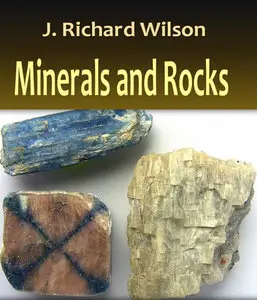"Minerals and Rocks" by J. Richard Wilson
BoBoCoAe, JRW & Ventus Publishing ApS | 2010 | ISBN: 8776816478 9788776816476 | 163 pages | PDF | 5 MB
BoBoCoAe, JRW & Ventus Publishing ApS | 2010 | ISBN: 8776816478 9788776816476 | 163 pages | PDF | 5 MB
This text presents the physical properties of minerals and an introduction to crystallography. The most important rock-forming minerals are then dealt with in a systematic way, followed by the three main rock groups – igneous, sedimentary and metamorphic. A lecture course in Minerals and Rocks must be accompanied by a parallel sequence of practical classes
The first version of this text was written to serve as lecture notes for a first term geology course in “Minerals and Rocks” at Aarhus University in Denmark in 2003.
Contents
Preface
1. Introduction
1.1 Igneous rocks
1.2 Sedimentary rocks
1.3 Metamorphic rocks
1.4 The Rock Cycle
2. Minerals - an Introduction
2.1 Definition of a mineral
2.1.1 Polymorphs
2.2 Properties of minerals
2.2.1 Crystal form growth habit and twinning
2.2.2 Cleavage and fracture
2.2.3 Lustre
2.2.4 Colour
2.2.5 Streak
2.2.6 Hardness
2.2.7 Tenacity
2.2.8 Density-
2.2.9 Other properties
3. Crystallography
3.1 Symmetry
3.2 Crystal systems
3.3 Crystal classes
3.4 Indices of crystal faces
4. Systematic Mineralogy
4.1 Silicate minerals
4.1.1 Nesosilicates
4.1.2 Sorosilicates (epidote)
4.1.3 Cyclosilicates
4.1.4 Inosilicates
4.1.5 Phyllosilicates
4.1.6 Tectosilicates
4.2 Non-silicate minerals
4.2.1 Native elements
4.2.2 Sulphides
4.2.3 Oxides
4.2.4 Chlorides and fluorides
4.2.5 Carbonates
4.2.6 Sulphates
4.2.7 Phosphates
5. Igneous rocks
5.1 Classification of igneous rocks
5.1.1 Plutonic rocks
5.1.2 Volcanic rocks
5.1.3 Mineral assemblages
5.2 Magma
5.2.1 Where does magma come from?
5.2.2 The composition of magma
5.2.3 Temperature
5.2.4 Viscosity
5.2.5 Density
5.3 Eruption of magma
5.3.1 Non-explosive eruptions
5.3.2 Explosive eruptions
5.4 Volcanoes
5.4.1 The shapes of volcanoes
5.4.2 Calderas
5.5 Plutonic rocks
5.5.1 Minor intrusions (dykes and sills)
5.5.2 Major intrusions (plutons)
5.5.3 Chilled margins
5.6 The origin of magma
5.6.1 Distribution of volcanoes
5.6.2 Origin of basaltic magma
5.6.3 Origin of andesitic magma
5.6.4 Origin of rhyolitic magma
5.6.5 Crystallization of magmas
5.7 Igneous mineral deposits
6. Sedimentary rocks
6.1 Introduction
6.2 Weathering
6.3. Classification of sedimentary rocks
6.3.1 Clastic sedimentary rocks
6.3.2 Biochemical sedimentary rocks
6.3.3 Organic sedimentary rocks
6.3.4 Chemical sedimentary rocks
6.4 Sedimentary structures
6.4.1 Layering (bedding)
6.4.2 Surface markings
6.4.3 Graded bedding
6.5 Where do sediments form?
6.5.1 Terrestrial environments
6.5.2 Marine environments
7. Metamoiphic rocks
7.1 Introduction
7.2 Metamorphism - causes and effects
7.2.1 Heat
7.2.2 Pressure
7.2.3 Water
7.2.4 Differential stress
7.3 Types of metamorphic rocks
7.3.1 Non-foliated metamorphic rocks
7.3.2 Foliated metamorphic rocks
7.3.3 Types of protolith
7.4 Grades of metamorphism
7.4.1 The progressive metamorphism of shale
7.4.2 Index minerals and metamorphic zones
7.4.3 Metamorphic facies
7.4.4 Geothermal gradients
7.5 Environments of metamorphism
7.5.1 Burial metamorphism
7.5.2 Blueschist facies and eclogite facies metamorphism
7.5.3 Regional metamorphism
7.5.4 Thermal metamorphism
7.5.5 Dynamic metamorphism
7.5.6 Metamorphism at mid-ocean ridges
7.6 Where do metamorphic rocks occur?
with TOC BookMarkLinks



